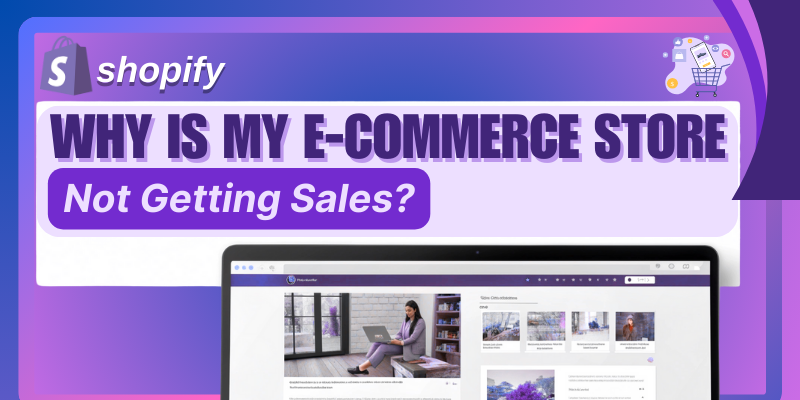E-commerce has become an essential part of the global marketplace, providing countless opportunities for businesses to reach customers far and wide. However, many e-commerce entrepreneurs ask, “Why is my ecommerce store not getting sales?” Some stores struggle to convert visitors into paying customers despite investing time, money, and effort into e-commerce websites or partnering with an e-commerce agency.
The e-commerce industry is highly competitive, and without a well-optimized strategy, it can be easy to lose potential sales. Whether you’re running a B2C e-commerce store or engaging in business-to-business e-commerce, there are various reasons your online store might not perform as expected.
In this article, we’ll explore why your store might not make sales and provide solutions to help you turn things around. From e-commerce marketing strategies to e-commerce website development, we’ll cover the essentials you need to boost your store’s performance.
Lack of Traffic to Your E-Commerce Store
One of the primary reasons your e-commerce store isn’t making sales could be a lack of traffic. If you’re not driving enough visitors to your website, it’s impossible to convert them into customers, regardless of how well-designed your site is.
Reasons for Low Website Traffic
- Inadequate SEO: Without e-commerce SEO services, your website might be challenging to find. Search engine optimization (SEO) ensures your products rank well on search engines like Google. If you’re not using the right keywords or optimizing your e-commerce websites in India and globally, your store may remain invisible to potential customers.
- Limited Marketing Reach: Your audience might be too narrow without the right marketing tactics. Whether using e-commerce platforms or relying solely on organic traffic, casting a wider net through paid advertisements and social media marketing is essential.
How to Increase Traffic to Your Store
- E-Commerce SEO: You can drive organic traffic to your e-commerce store by optimizing your website for e-commerce SEO. This means ensuring product pages have well-structured, keyword-rich descriptions, optimized images, and meta tags.
- Paid Ads and Social Media Marketing: Paid marketing campaigns via platforms like Google Ads or Facebook Ads can help target the right audience quickly. Similarly, e-commerce digital marketing agencies can help design campaigns that effectively target potential customers.
- Content Marketing and Blogging: Start a blog and create valuable content that can attract organic traffic. Content marketing is an excellent way to establish your brand as an authority in the industry and bring in customers through search engines.
Poor Website User Experience
A poor user experience is one of the most damaging reasons your e-commerce store may not convert. Customers who have difficulty navigating your site or find it unresponsive are less likely to follow through with a purchase.
How Slow Loading Times Hurt Sales
- High Bounce Rate: Slow loading times can lead to a high bounce rate, meaning visitors leave your site before exploring your products. This directly impacts sales, especially for e-commerce websites in India, where internet speed can be a concern.
- Lost Revenue: According to studies, 40% of users abandon a website that takes more than 3 seconds to load. A slow website can result in missed opportunities, particularly if you rely on e-commerce solutions to bring in high-quality traffic.
Improving User Experience
- Improve Site Speed: To ensure that your e-commerce store loads quickly, consider working with e-commerce website development experts who can help you optimize your site’s speed by compressing images, minimizing HTTP requests, and using Content Delivery Networks (CDNs).
- Mobile Optimization: With e-commerce in India and globally seeing a rise in mobile shopping, ensuring your website is fully responsive and mobile-friendly is crucial. Your e-commerce mobile app development company can help with this.
- Streamline Navigation: Ensure that users can easily find the products they seek. Use clear categories, filters, and a search bar that allows users to navigate your store easily.
Ineffective Product Pages
Your product pages are the heart of your e-commerce site. If these pages are not optimized or lack essential elements, customers may not feel compelled to purchase.
How Product Descriptions Affect Sales
- Lack of Detail: If your product descriptions are too vague or fail to highlight key features and benefits, visitors may not trust your products enough to purchase them.
- SEO-Optimized Descriptions: Without the right keywords incorporated into your product descriptions, search engines might not index your page, reducing your visibility to potential customers.
How to Improve Product Pages
- Clear and Engaging Descriptions: Write compelling product descriptions that highlight the benefits and include relevant e-commerce keywords. Please ensure they are unique and optimized for search engines to improve visibility.
- High-Quality Visuals: Use high-quality images and videos that showcase the product, offering potential buyers a closer look. This can also be achieved by working with an e-commerce app development company that supports rich media for your product pages.
- Social Proof and Reviews: Adding reviews from previous customers can significantly increase credibility. E-commerce security solutions ensure that user-generated content is safe so customers can trust the feedback shared on your site.
Unclear or Complicated Checkout Process
If your checkout process is complicated or unclear, customers may abandon their carts before completing the purchase. A smooth and easy checkout process is essential to convert visitors into customers.
Transform Your Digital Presence
Get personalized strategies and solutions tailored to your business needs.
- Free Initial Consultation
- Custom Solution Planning
- Expert Team Support
Why a Complicated Checkout Process Leads to Cart Abandonment
- Long Forms: Customers may drop out if the checkout process involves too many steps or requires too much information. A long form is a significant barrier to purchase, especially for those looking for a quick and easy shopping experience.
- Limited Payment Methods: If customers cannot use their preferred payment method, they may abandon their carts and look for alternatives.
How to Streamline the Checkout Process
- Simplified Forms: Minimize the number of fields in the checkout process. A guest checkout option can reduce friction for first-time customers.
- Multiple Payment Methods: Offer various payment options, including credit/debit cards, PayPal, Apple Pay, and even cash-on-delivery (COD) for local customers. Ensure that payment security is top-notch by partnering with e-commerce security solutions companies.
- Transparent Shipping Fees: Make sure that shipping costs are clear upfront. Surprise fees can deter customers from completing their purchases.
Not Using Retargeting Strategies
One of the most potent tools in e-commerce marketing is retargeting. If you’re not using retargeting, you’re missing out on a valuable opportunity to convert past visitors into buyers.
How Retargeting Can Boost Sales
- Persistent Visibility: Retargeting ensures that customers who’ve visited your site and left without purchasing are reminded of the products they viewed. This persistent visibility increases the likelihood of conversions.
- Personalized Ads: By creating personalized ads featuring the exact products customers viewed, you can encourage them to return and complete the purchase.
How to Set Up Retargeting Ads
- Use Platforms Like Google and Facebook: Retargeting ads can be set up easily through e-commerce platforms like Google Ads or Facebook, which allow you to show ads to users who have visited specific pages or added items to their cart.
- Create Compelling Ads: Show personalized promotions or discounts in your ads to incentivize visitors to return to your site and finish their purchase.
Price Sensitivity and Competition
Pricing plays a significant role in whether customers make a purchase. If your prices are too high compared to competitors, or if you aren’t offering compelling reasons for customers to buy, your e-commerce store may struggle to convert visitors.
Analyzing Competitor Pricing
- Market Research: Keep a close eye on your competitors’ pricing strategies. If your prices are too high, offer additional value to justify the difference, or consider adjusting them based on market trends.
- Price Comparison Tools: Use e-commerce business models that involve dynamic pricing, which adjusts your prices based on demand, competition, and other factors.
Offering Promotions to Attract Customers
- Discounts and Deals: Offer regular discounts, time-limited offers, and free shipping to make your products more attractive. Many e-commerce solutions companies can help automate promotions to make this process seamless.
Lack of Trust and Credibility
Building trust is one of the most essential aspects of running a successful e-commerce store. Without trust, visitors will not feel comfortable providing their payment information or making a purchase.
Building Trust Through E-Commerce Security Solutions
- SSL Certificates: Secure your e-commerce site with an SSL certificate to encrypt sensitive customer data. This small step can significantly improve your store’s credibility.
- Customer Reviews and Testimonials: Display customer reviews, ratings, and testimonials prominently on your product pages to build trust and showcase the quality of your products.
How to Improve Credibility
- Clear Policies: Clearly state your shipping, return, and privacy policies to alleviate concerns about customer satisfaction.
- Security Features: Highlight your use of e-commerce security solutions to assure customers that their data and transactions are secure.
Conclusion
The reasons could be multifaceted if your e-commerce store isn’t generating sales. Addressing these core issues, from lack of traffic to poor website user experience or unclear pricing strategies, will set you on the right path. You can significantly improve your conversion rates by focusing on e-commerce marketing, optimizing your product pages, and leveraging e-commerce solutions.
Implementing a solid e-commerce SEO strategy, improving user experience, retargeting ads, and building customer trust will help drive more visitors and ultimately increase sales. Don’t be afraid to leverage e-commerce agencies and e-commerce companies specializing in e-commerce website development to help refine your approach.





